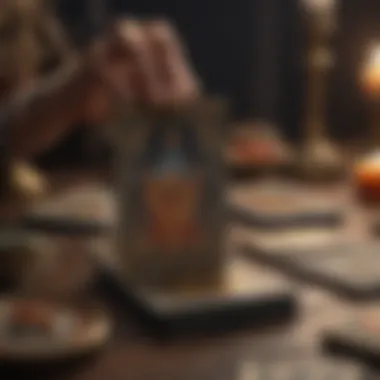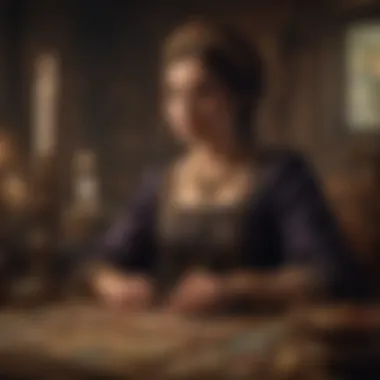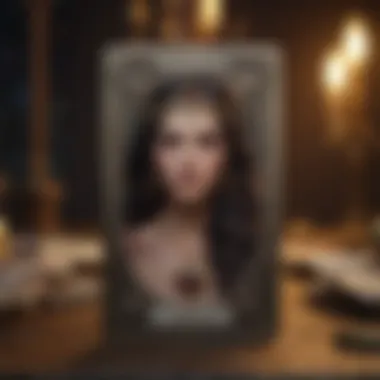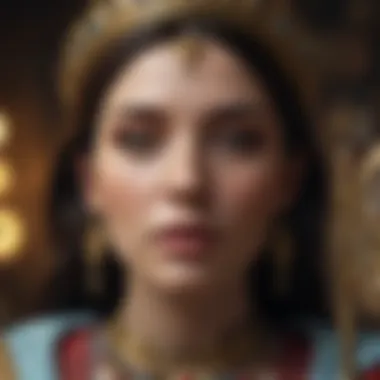Exploring the Accuracy of Tarot Cards: Insight or Illusion?


Intro
The world of tarot cards is often shrouded in mystique and speculation. Many seekers turn to tarot as a tool for insight, yet questions about its accuracy frequently arise. This article aims to dissect the layers of tarot card readings, shedding light on their historical roots, interpretative challenges, and the psychological aspects influencing their perceived reliability. By investigating the factors that come into play—cultural backgrounds, personal experiences, and user interpretations—readers can gain a nuanced understanding of tarot's role in self-reflection.
Zodiac Sign Overview
While tarot readings themselves do not directly hinge on zodiac signs, understanding these astrological elements can enhance one's approach to tarot. Each tarot card can resonate differently based on the astrological influences, and knowing these can lead to more insightful readings.
General Traits and Characteristics
Each zodiac sign carries its unique traits and energies. For instance, Aries is often viewed as assertive and impulsive, while Pisces embodies sensitivity and intuition. Recognizing these traits can inform how tarot interprets personal situations depending on one's astrological sign.
Elemental Associations
Zodiac signs are categorized into four elements: Fire, Earth, Air, and Water. Each element contributes distinct qualities to its signs:
- Fire: Aries, Leo, Sagittarius — represents passion and energy.
- Earth: Taurus, Virgo, Capricorn — denotes stability and materialism.
- Air: Gemini, Libra, Aquarius — symbolizes intellect and communication.
- Water: Cancer, Scorpio, Pisces — embodies emotion and intuition.
Tarot readings can be influenced by these elemental associations. For example, a fire sign may find decisive action reflected in certain cards more prominently than an earth sign.
Ruling Planets
Each zodiac sign is also associated with specific ruling planets, which influence their characteristics. Understanding these connections can provide deeper insights into tarot readings. For example:
- Aries: Mars — associated with aggression and drive.
- Taurus: Venus — linked with love and beauty.
- Scorpio: Pluto — connected with transformation and power.
Each planet brings its influence to interpret the meanings behind the chosen tarot cards.
Compatibility Analysis
Understanding zodiac compatibility can add another layer to tarot card readings. The dynamics based on sun signs help identify emotional connections and possible conflicts.
Relationship Dynamics with Other Zodiac Signs
Each sign has its relation dynamics that can impact tarot readings:
- Complementary Signs: Some signs naturally align, enhancing their compatibility.
- Challenging Matches: Other combinations may face difficulties, suggesting conflicts.
Friendship Compatibility
Equally important is how friendships reflect zodiac energies. Friends with complementary signs can uplift each other, while those with contrasting signs may challenge and teach lessons.
Family and Workplace Relationships
Tarot readings often touch on family and workplace dynamics. Knowing the zodiac influences can help interpret interpersonal situations presented in tarot. Certain signs might excel in team settings while others may thrive in independent roles.
Astrological Influences
Astrological phenomena significantly affect tarot readings and personal insights. Celestial movements can shift energies influencing the outcomes of tarot card interpretations.
How Current Celestial Events Affect Each Sign
Astrological events such as retrogrades, eclipses, or alignments can alter energies for each sign, creating new opportunities for reflection. Observing these patterns can improve tarot readings’ relevance.
Monthly and Weekly Influences
Tarot readings can also be adapted based on monthly or weekly influences of astrological transitions. Certain periods may favor specific sign energies, prompting deeper insights.
Personal Growth Opportunities Through Astrology
Astrology encourages personal growth, and tarot can uncover paths for development. Combining both can provide guidance and clarity in navigating life challenges.
By intertwining astrology with tarot, practitioners can develop a more comprehensive approach to understanding readings.
This exploration of tarot offers a framework for deeper comprehension. By appreciating the historical context and cultural significance, users can engage with tarot more thoughtfully.
Preface to Tarot Cards
Tarot cards have captivated human interest for centuries. They serve not only as a tool for divination but also as a medium for self-reflection and personal insight. Understanding the foundational elements of tarot is essential for evaluating its accuracy, as this informs how practitioners approach readings and interpret results.
The significance of tarot cards lies in their complex structure and the symbolism embedded within each card. The imagery invites users to connect with their subconscious, making the reading experience both personal and subjective. This layer of interpretation plays a critical role in perceived accuracy, as different users may derive varied insights from the same card layout.
By exploring the historical background and card structure, one gains a clearer perspective on how tarot has evolved. Factors such as cultural context and psychological principles are vital to understanding why many individuals regard tarot readings as credible. In the following sections, we will examine these aspects to uncover the various dynamics at play when evaluating the accuracy of tarot card readings.


Historical Background
The origins of tarot cards can be traced back to the 15th century in Europe, where they were initially used for playing games. The transformation of tarot into a tool for divination occurred during the 18th century, fueled by interest in mysticism and the occult. This shift marked the beginning of tarot's association with fortune-telling and spiritual guidance.
Different cultural traditions influenced the development of tarot decks, leading to a variety of card designs and interpretations. The Rider-Waite-Smith deck, created in the early 20th century, is one of the most popular and widely used decks today. Its imagery has shaped modern tarot interpretations and serves as a foundation for many other decks that followed.
Understanding the historical context helps practitioners appreciate the depth and richness surrounding tarot practices. Tarot's evolution has created layers of meaning that can enhance or complicate the reading experience.
Card Structure and Types
Tarot decks typically consist of 78 cards, divided into the Major and Minor Arcana. The Major Arcana comprises 22 cards, each representing significant life themes, spiritual lessons, and archetypal energies. In contrast, the Minor Arcana consists of 56 cards, divided into four suits: Cups, Pentacles, Swords, and Wands. Each suit relates to different aspects of life, such as emotions, finances, intellect, and action.
Each card has its own imagery, symbolism, and meanings, allowing for a multitude of interpretations. The arrangement of the cards in a spread can further influence the reading's significance.
When evaluating the accuracy of tarot readings, understanding the foundational structure of the cards is crucial. It enables practitioners to grasp the nuances involved in each reading. Thus, the details surrounding card types and their implications warrant careful consideration.
Understanding Accuracy in Tarot Readings
Understanding accuracy in tarot readings is essential for anyone interested in the practicality and effectiveness of tarot as a tool for insight. Many people seek tarot readings for guidance in various aspects of life, ranging from personal relationships to career decisions. The perceived accuracy of these readings greatly influences their trust and reliance on this divination method.
This section explores the critical elements that contribute to defining accuracy in tarot. It brings into focus how personal biases, interpretations, and user expectations shape the outcomes of readings. By diving into this topic, readers can gain a better appreciation of how accuracy operates in the realm of tarot, allowing them to engage with it more meaningfully.
Defining Accuracy
Accuracy in tarot cannot be viewed through a single lens. It is a multi-faceted concept that often varies from one individual to another. Commonly, it refers to how well the information derived from a tarot reading resonates with the querent’s situation or feelings. Factors such as the reader’s skill level, the contextual cards drawn, and the overall reading technique all intersect to influence accuracy.
Tarot readings can often be subjective; thus, while some may find a reading highly accurate, others may interpret it differently. This divergence adds complexity to our understanding of what accuracy really means. Some tarot practitioners might suggest that accuracy manifests not merely in predictive capacity but also in providing clarity and reflection for the querent.
Subjective vs.
Objective Measures To evaluate the accuracy of tarot readings, one must distinguish between subjective and objective measures.
- Subjective Measures: This includes personal feelings and reflections of the individual receiving the reading. Many clients mention how a reading aligns with their inner thoughts or beliefs. Emotional resonance here is crucial. If a reading strikes a chord with someone’s feelings or circumstances, they are likely to perceive it as accurate, even if predictions don’t precisely match future events.
- Objective Measures: These refer to measurable outcomes, such as recorded predictions and their subsequent realizations. This could involve tracking the accuracy of specific readings over time. While this method offers a more scientific approach, it has its limitations. Predictions in tarot are often vague or based on personal intuition, making them hard to quantify.
In the context of tarot, blending both subjective and objective measures offers a better understanding of accuracy. It encompasses both personal insight and measurable outcomes. As a result, readers, practitioners, and querents can foster more in-depth communication and enhance the experience of tarot as a valuable tool for self-understanding.
“The measure of tarot accuracy lies in dialogue between the reader and querent.”
By contemplating the blend of these measures, tarot enthusiasts can better navigate their readings, leading to insights and discoveries that resonate deeply with their personal journey.
Psychological Underpinnings
Understanding the psychological underpinnings of tarot readings is crucial when evaluating their accuracy. This perspective opens doors to comprehending how human behavior, belief systems, and cognitive functions interact with the tarot experience. By analyzing this intersection, we can better appreciate the complexities involved in interpreting tarot cards and their perceived reliability.
The Role of Interpretation
In tarot readings, interpretation plays a pivotal role. The meanings assigned to each card are not universally fixed; they vary significantly depending on the reader and the context. A tarot interpretation is as much about the reader's insight and intuition as it is about the cards themselves. This subjectivity raises questions about accuracy.
When a reader engages with the cards, personal intuition and psychological states influence which meanings are drawn out. Each card might spark differing interpretations based on the reader’s current thoughts and feelings or the client’s life circumstances. Consequently, one card could resonate differently in various readings, affecting the perceived accuracy of the insight provided. Understanding this nuance is essential for anyone exploring tarot as a tool for insight.
“The strength of a tarot reading often lies not just in the cards themselves, but in the connection forged between reader and seeker.”
Considerations for Interpretation
- Context-Sensitivity: The situation surrounding the reading matters. A card that symbolizes caution may be interpreted as a warning in one context and as a call for mindfulness in another.
- Symbolic Nuances: Every card carries multiple layers of meanings and can evoke different emotional responses.
- Reader's Background: A reader’s personal experiences can shape their interpretations. An individual with a background in psychology may approach readings differently than one with a spiritual or philosophical focus.
Readers should thus cultivate awareness of their interpretative processes. A clear understanding can lead to more refined and, ultimately, more accurate readings.
Cognitive Bias and User Expectations
Cognitive bias and user expectations create a complex environment that affects tarot reading accuracy. These factors shape how clients perceive their readings. Often, individuals seek tarot readings during times of uncertainty or stress. This need can influence their receptivity and interpretation of the messages conveyed.
Common Cognitive Biases in Tarot Readings
- Confirmation Bias: Users may focus on information that confirms their pre-existing beliefs, ignoring details that might challenge those views.
- Expectation Bias: The degree of belief in the tarot's effectiveness can alter the interpretation and emotional reception of the reading. If a user expects a particular outcome, they may interpret the cards in a way that aligns with their hope or fear.
- Framing Effect: How a question is framed can lead to different interpretations. For instance, asking “Will I find love?” might yield different emotional responses compared to “What should I do about my love life?”
Users should approach readings with an open mind. Being mindful of these biases can lead to more fruitful engagements with the tarot. It allows users to gain deeper insights rather than seeking specific confirmations of what they already believe.
Overall, understanding the psychological foundations that underpin tarot readings is vital for anyone engaging with this practice. Recognizing how interpretation, cognitive biases, and user expectations shape experiences can lead to more meaningful outcomes, enhancing the perceived accuracy of tarot as a tool for insight.
Cultural and Social Influences
Cultural and social influences play a significant role in shaping how tarot cards are perceived and utilized. Understanding these influences is crucial for anyone interested in evaluating the accuracy of tarot readings. The perceptions around tarot are often colored by cultural contexts and societal trends, impacting how individuals interpret card meanings and outcomes.
Cultural Significance of Tarot


The cultural significance of tarot cards extends beyond mere divination. Historically, tarot has been infused with various meanings depending on the region and time period. In Europe, tarot cards originated as a playing game in the 15th century, but by the 18th century, they began to be seen as tools for insight and fortune-telling.
Cultural interpretations of tarot vary widely. For instance, in some spiritual communities, tarot is seen as a path to personal enlightenment. In others, it is a subject of skepticism and dismissal. This diverse cultural landscape influences how users engage with tarot. Factors such as regional beliefs, religious backgrounds, and historical events feed into a person's perception, often shaping their expectations of accuracy.
Furthermore, the imagery on tarot cards, often rich with symbols and archetypes, draws from various cultural narratives. This connection can evoke deep emotional responses that affect a user’s experience and interpretation during readings. Contemplating the cultural layers behind tarot enhances its significance and perceived accuracy.
Peer Influence and Group Dynamics
Peer influence and group dynamics have a profound effect on how individuals approach tarot readings and interpret their outcomes. People often seek validation from their social circles, which influences their beliefs about the accuracy of readings. If a person's friends or community members harbor skepticism towards tarot, this might lead to doubts about its efficacy.
In group settings, the collective energy and shared beliefs can amplify or dampen the perceived accuracy of readings. For instance, if a group of individuals engages in a tarot session collectively, their interpretations may align, enhancing the sense of validation around the reading. Conversely, dissenting opinions within a group can create an atmosphere of uncertainty, affecting individual readings.
- Supportive Environments: When individuals participate in supportive group dynamics, they may feel more liberated to explore and express their interpretations of card meanings. This can lead to enriched understanding and nuanced insights.
- Skeptical Contexts: In environments where skepticism prevails, individuals may be reluctant to fully engage with the cards. This can limit the depth of insight that could be gained during readings.
Overall, the interplay of cultural significance and group dynamics significantly shapes the user experience, ultimately impacting perceptions of accuracy in tarot readings.
User Experiences and Testimonials
Understanding user experiences and testimonials provides a critical lens through which to evaluate the accuracy of tarot card readings. These real-life accounts serve multiple purposes. Firstly, they can shed light on individual perceptions of accuracy, which often differ greatly from person to person. Each user brings unique perspectives shaped by their own background, beliefs, and experiences. As such, analyzing these varied testimonials can help identify common themes or divergences in what individuals consider to be an accurate reading.
Moreover, user testimonials can validate or challenge the claims made by practitioners regarding tarot's effectiveness. Insights drawn from real cases can either reinforce the perceived legitimacy of tarot readings or expose exaggerated expectations. Understanding this dynamic is essential because it allows both practitioners and clients to adjust their approaches to tarot.
Lastly, engaging with user experiences can foster a sense of community within the tarot realm. When individuals share their stories, it can create connections among users who have similar experiences or challenges. This encourages discourse that can further enhance the understanding of tarot's role in their lives.
Common User Perspectives
In exploring common user perspectives, several key viewpoints emerge regarding the accuracy of tarot readings:
- Skepticism: Many users approach tarot with a healthy dose of skepticism. They often question the validity of the readings, attributing outcomes to coincidence rather than any mystical influence. The skeptical perspective emphasizes the need for tangible evidence and rational explanations, which can undermine faith in the practice.
- Personal Insight: Alternatively, some users view tarot as a valuable tool for self-discovery and personal insight. They may find that card readings resonate deeply with their current life situations or uncertainties. This perspective suggests that the apparent accuracy of tarot is tied to its ability to reflect the inner thoughts and feelings of the user rather than any external divinatory power.
- Empowerment: Numerous users report feeling empowered after a tarot session. By gaining clarity or understanding from the readings, they may feel more equipped to tackle challenges or make decisions. This sense of empowerment doesn't just signify accuracy but also highlights the therapeutic potential tarot holds for many.
These perspectives illustrate the complexity of interpreting tarot readings and the importance of context in discussions about accuracy.
Evaluating Feedback and Outcomes
Evaluating feedback and outcomes of tarot readings is a nuanced process. Users often reflect on their experiences to determine if the readings provided value or clarity. Here are some important aspects to consider when assessing this feedback:
- Comparison of Expectations: Users frequently assess the outcomes of a reading against their initial expectations. If a tarot session aligns favorably with what users hoped to gain, they may regard it as accurate or insightful. Conversely, if the outcomes diverge significantly, skepticism may ensue.
- Time Frame for Evaluation: The accuracy of tarot readings may also be evaluated over time. What seems irrelevant in the moment can become meaningful weeks or months later. This delayed recognition complicates immediate assessments but adds depth to understanding accuracy.
- Contextual Relevance: Each tarot reading occurs within a specific context. Users should account for their psychological state, situational factors, and personal biases when interpreting what a reading means to them.
- Reporting Mechanisms: Many users express their experiences through online platforms or social networks. Websites like Reddit or Facebook groups are prominent spaces where these discussions occur. Supplementing personal anecdotes with community feedback can provide a broader view of perceived accuracy and outcomes.
By weighing user perspectives and evaluating feedback, insight emerges regarding not only the accuracy of tarot cards but also their broader implications for users' lives.
In summary, the user experiences and testimonials surrounding tarot readings highlight the diverse interpretations and outcomes. Examining these accounts contributes to a comprehensive understanding of accuracy that goes beyond mere card interpretations.
Common Misconceptions about Tarot Cards
Understanding common misconceptions about tarot cards is crucial for both practitioners and seekers. These misunderstandings often cloud perceptions about tarot's utility and effectiveness. By addressing these misconceptions, individuals can approach tarot with a clearer mind and recognize its potential as a tool for insight.
Debunking Myths
Many individuals associate tarot cards with dark magic or occult practices. This myth can deter people from exploring tarot's true nature. In reality, tarot is a set of cards designed to prompt reflection and provoke thought. It is not about fortune-telling in a mystical sense, but rather a method for self-discovery and understanding.
- Myth: Tarot Predicts the Future
- Myth: Only Certain People Can Read Tarot
- Myth: Tarot Cards Are Dangerous
- Reality: Tarot does not predict the future. It provides a framework for contemplating one's current circumstances and potential outcomes.
- Reality: Anyone can learn to read tarot. It requires practice and understanding of symbolism rather than innate psychic powers.
- Reality: Tarot is simply a tool. The interpretation and context of its use determine its impact, not the cards themselves.
These myths can lead to the marginalization of tarot as a valid pathway for introspection. By debunking these prevalent beliefs, practitioners can foster a healthier dialogue around the practice.
Recognizing Tarot's Limitations
Acknowledging the limitations of tarot cards is essential. Tarot is not a definitive answer to life's challenges. Instead, it presents possibilities and insights.
- Not a Substitute for Professional Help: Tarot should never replace psychological or medical advice. Those seeking cues about critical life decisions should consult professionals.
- Subject to Interpretation: The reading can vary greatly depending on the reader's interpretation. Different readers may arrive at different conclusions from the same spread.
- Context Matters: The effectiveness of tarot is highly contextual. The environment, individual mindset, and the specific question asked all significantly impact the reading.
In summary, while tarot has considerable value, its limitations must be recognized and respected. Practitioners should encourage potential users to approach tarot as a constructive tool, rather than as infallible guidance.
Practical Tips for Engaging with Tarot
Engaging with tarot can be a deeply personal and insightful practice. To enhance the accuracy and effectiveness of readings, it is crucial to approach the art of tarot mindfully. This section focuses on practical tips, beginning with the selection of a deck and the creation of an environment suitable for reflection and interpretation. Both elements play significant roles in how accurately one can connect with the cards and their meanings.
Selecting a Deck
Choosing the right tarot deck is essential. There are numerous decks available, each with its own artistic flair and symbolism. Here are several factors to consider:


- Personal Resonance: Look for decks that speak to you. The imagery and design should resonate with your intuition. A deck that evokes a strong emotional response can facilitate deeper insights during readings.
- Guidance Material: Some decks come with comprehensive guidebooks. These resources can provide context for each card, making it easier to understand their meanings. This is particularly helpful for beginners.
- Traditional vs. Modern: Decide if you prefer a traditional deck, like the Rider-Waite-Smith, or a more contemporary option. Traditional decks often have established meanings, while modern variants may offer innovative interpretations.
- Usability: Consider the size and texture of the cards. They should feel comfortable in your hands and be easy to shuffle. If a deck is difficult to handle, it might affect the reading process.
This careful selection process can greatly enhance one’s connection to the cards, thereby improving the overall experience of tarot readings.
Creating a Conducive Environment
The setting in which readings take place is just as important as the tools used. A conducive environment is vital for focusing energy and promoting clarity during tarot sessions. Here are effective tips for setting the right atmosphere:
- Quiet Space: Find a quiet place where interruptions are minimized. Silence helps in concentrating on the reading and opens the mind to insights.
- Lighting: Soft, natural lighting or candles can create a peaceful ambiance. Avoid harsh fluorescent lights, as they can be distracting.
- Personal Comfort: Comfortable seating is essential. You might want to include cushions or blankets to make the space inviting.
- Remove Distractions: Turn off electronic devices or put them on silent mode. This prevents distractions that can disrupt the flow of the reading.
- Incorporate Rituals: Some practitioners find it helpful to engage in rituals, such as meditation or breathing exercises, before starting a reading. This can help clear the mind and align energies.
By paying attention to these aspects, one can create an atmosphere that promotes accurate readings and a deeper understanding of the messages conveyed through the cards.
The Role of Intuition in Tarot Reading
Intuition plays a vital role in the practice of tarot reading. It informs the reader's interpretation of the cards, guiding their decisions and insights. Understanding this aspect can help practitioners enhance their readings and develop a deeper connection with the cards.
Benefits of Intuition in Tarot
- Enhanced Insight: Intuition often reveals aspects of a situation that are not immediately obvious. It helps the reader connect the dots between the cards and the querent's life circumstances.
- Personalization: Each reader has a unique style. Intuition allows for a more tailored approach, aligning the reading with the querent's specific needs.
- Improved Clarity: When readers trust their gut feelings, the clarity of the reading often improves. This can lead to more coherent interpretations.
Despite its importance, relying solely on intuition can be risky. Readers should balance their intuitive feelings with the meanings of the cards to create well-rounded interpretations.
Intuitive Decision-Making
Making decisions during a tarot reading often involves an intuitive process. The reader must quickly assess various elements such as the card positions, imagery, and the querent's energy. This requires being attuned to subtle cues and feelings.
The key factors in intuitive decision-making include:
- Active Listening: Paying attention to the querent's words and emotions enables deeper understanding.
- Observing Body Language: Physical cues can reveal much about a querent's feelings and thoughts.
- Trusting Gut Instincts: Readers should cultivate a sense of trust in their instincts. Often, they know when something resonates or feels right.
Balancing Intuition and Card Meaning
While intuition is powerful, it’s imperative to pair it with the card meanings for accuracy. Each tarot card has established symbolism and connotations, which provide context to the intuitive insights. Recognizing this balance is crucial for effective readings.
Consider the following practices:
- Study Card Meanings: A strong grasp of traditional interpretations helps ground intuitive insights.
- Reflect on Personal Experiences: Each reader may have unique associations with cards based on personal experiences. Incorporating this knowledge can enrich interpretations.
- Seek Feedback: Engaging with other practitioners allows one to refine their approach, merging intuition with established meanings.
In summary, the interplay between intuition and card meaning creates a more impactful reading experience. Balancing these two elements is essential for both the reader and the querent.
The Future of Tarot as a Tool for Insight
The landscape of tarot reading is evolving. This evolution is essential, as it shapes how practitioners and seekers perceive and utilize tarot cards. As societal interests shift, so too do the applications and understanding of tarot. This section aims to highlight specific elements, benefits, and considerations that will influence the future of tarot as a valuable tool for insight and guidance.
Emerging Trends in Tarot Reading
A few significant trends are shaping how tarot is practiced and experienced. First, there's a noticeable shift toward inclusivity and diversity in tarot communities. Contemporary decks are being created that reflect varied cultural narratives and experiences, which make tarot more accessible.
Another trend is the integration of specialized readings tailored to mental health and emotional well-being. Many practitioners are adapting classic spreads to focus on personal struggles, making tarot not just a divination tool but also a means for therapeutic exploration.
In addition, workshops, online courses, and social media discussions have become more prominent. This not only elevates tarot knowledge but fosters a global community. Practitioners are sharing methods, tips, and interpretations, enriching the overall practice. Collaboration among readers—with different styles and approaches—has started to flourish.
Integrating Technology with Tarot
The integration of technology into tarot practices opens new avenues for exploration and accessibility. Various mobile applications now provide digital interpretations of decks, allowing users to engage with tarot anytime and anywhere. Such tools can democratize tarot knowledge, making it readily available to a wider audience.
Virtual tarot readings have also gained traction, especially during the past few years. These readings can occur through video calls or instant messaging, breaking geographical barriers. Only a reliable internet connection is needed to consult a tarot reader from another part of the world.
Moreover, online platforms facilitate group readings, discussion forums, and community learning experiences. This means that the traditional one-on-one reading can now evolve into a more communal experience where multiple participants can interact. Incorporating tools like Zoom or Discord enables users to connect over their insights, strategies, and even shared beliefs about cards.
In summary, the future of tarot as a tool for insight looks promising. Emerging trends emphasize inclusivity and accessibility while technology brings new opportunities for engagement. As practitioners and seekers, adapting to these changes will enhance the richness of tarot as a method of understanding oneself and the world.
Culmination
In exploring the accuracy of tarot cards, it is essential to distill the main elements that contribute to their perceived reliability and effectiveness. This article highlights the intricate relationship between interpretation, user psychology, cultural context, and personal experience. Each aspect plays a role in shaping how tarot is understood and utilized. By evaluating these elements thoughtfully, readers can better appreciate the complexities of tarot as a tool for insight and reflection.
Summary of Insights
The investigation into tarot's accuracy reveals several key insights:
- Historical Context: Tarot has a rich history that adds depth to its practice. Understanding its origins helps inform its modern usage.
- Interpretation: The subjectivity inherent in interpreting tarot cards is critical. Readers bring their own biases and insights into the reading process, influencing outcomes.
- Psychological Factors: User expectations and cognitive biases significantly affect how readings are perceived and understood.
- Cultural Significance: Tarot exists within various cultural frameworks, impacting its acceptance and efficacy across different communities.
- User Feedback: Personal experiences and testimonials offer valuable insights. They can either reinforce or challenge the notion of accuracy in readings.
These points encompass the broad spectrum of considerations surrounding the accuracy of tarot cards, setting the stage for more nuanced discussions in the future.
Final Thoughts on Accuracy
The accuracy of tarot cards lies not only in the cards themselves but also in the interaction between the reader and the querent. Each reading is a unique event, shaped by several factors.
As practitioners engage with tarot, they must be aware of their own biases and the expectations they bring to the table. Acknowledging these influences can create more authentic and meaningful readings. It's also crucial to realize that tarot is not solely about divination but serves as a tool that can enhance self-awareness and personal growth. Therefore, the concept of accuracy should be viewed through a lens that includes emotional and psychological dimensions.
Ultimately, understanding the interplay between cards, interpretation, user experience, and cultural implications is essential for those interested in utilizing tarot effectively. This multifaceted approach will enrich the engagement with tarot as a reliable method for insight, leading to a more profound appreciation of its potential benefits.



